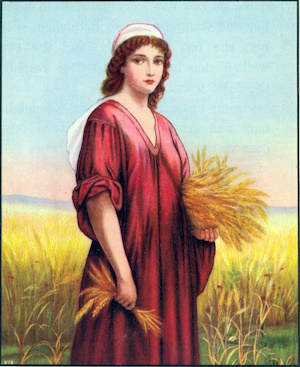
There have been books written and movies made about Ruth's story. Why? Because on the surface it is viewed as a love story and beloved by both Jews and Christians. Ruth is in the lineage of King David and of Jesus. But if you look beneath that surface there is a deeper story still. A story of rejection and acceptance and of a very brave women who gave up everything for love, not for romantic love but out of love and compassion for her mother-in-law.
In an earlier place in the Bible in Genesis, Abraham leaves Israel and goes down to Egypt during a famine, he does this without first seeking the guidance of the Lord and the results were NOT GOOD. In the beginning of the book of Ruth we have a similar situation, during a famine in Israel Elimelech takes his wife and 2 sons and moves to Moab. Moab are descendants of Lot, born of the incest between Lot and his daughters, they are a fallen people who failed to offer any hospitality or help to their cousins when the Hebrew slaves coming from Egypt, with Moses, passed through their land. They instead hired Balaam to curse them. They worship an Idol called Chemosh and practice human sacrifice of children, NASTY! Yet the family of Elimelech remain in Moab 10 years mixing with these people, when they should have returned to Israel as soon as the famine was over.
The sons come of age in Moab and the only women around are Moabite women. Jews are strongly instructed, not to marry foreign woman (outside of their religion), because they encourage children in idol worship.
Ruth however seems to have been a very good choice of wife.....she was a Moabite girl who married one of the boys, and she seems to have been caring, loving and intelligent. She has made a commitment not just to her new husband but to his family. When the men all die, Naomi the boys mother, tells the girls to return to their parents, while one of the girls is happy to return to her home, Ruth is not. She realizes Naomi is now old, alone and the two have a shared grief, Ruth refuses to leave her. But Naomi is determined to return to Israel, to her people and her God.
Out of love, caring and concern for Naomi, Ruth bravely makes the commitment that will change her life forever, to follow Naomi to Israel, leaving everything she knows behind her....family, culture and religion. Ruth essentially becomes a convert to Judaism, this is a huge thing for a young widow, to leave all support, life-style and possibly language behind to move to another country, where she might not be accepted and she had to walk there! A major journey and adventure.
Maybe Ruth knew the Jews religion was far kinder to woman and children than the one in which she was raised. But Gods at this time were believed to only operate within their own land and jurisdiction, so we don't really know how much she knew yet. Naomi would have had to teach Ruth what to expect and about the Lord, on that journey and once in Israel. None of this is the general stereotype of a daughter-in-law, mother-in-law relationship, we see depicted today. How worried about coming home bringing a foreign daughter-in-law, would Naomi have been? How well would the Israeli women have accepted Ruth's presence? Naomi may have thought it would not be easy for Ruth to gain acceptance in the community. But Ruth refused to leave her, they obviously had a strong bond, they had shared grief. Ruth refused to let Naomi struggle alone on a dangerous journey and die alone unsupported in Israel. Ruth had no idea that her love and care for Naomi would bring her great blessings in Israel, but Ruth's attitude obviously pleased the Lord, something for us all to think about.
 Welcome
Welcome Calendar
Calendar Today's Word
Today's Word Lauds
Lauds Terce
Terce Sext
Sext None
None Vespers
Vespers Compline
Compline Matins
Matins